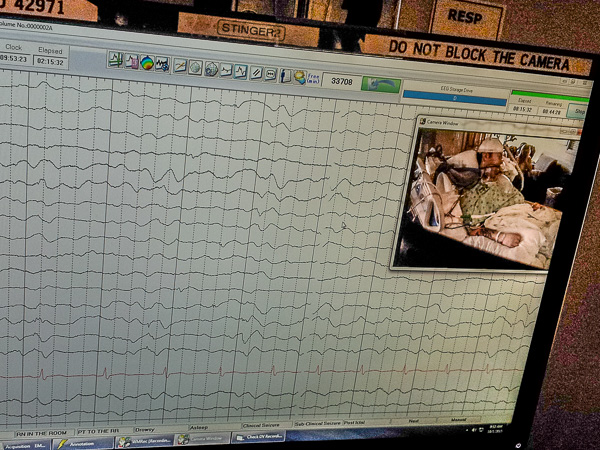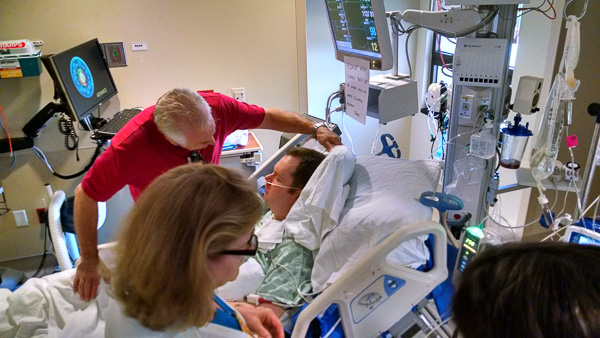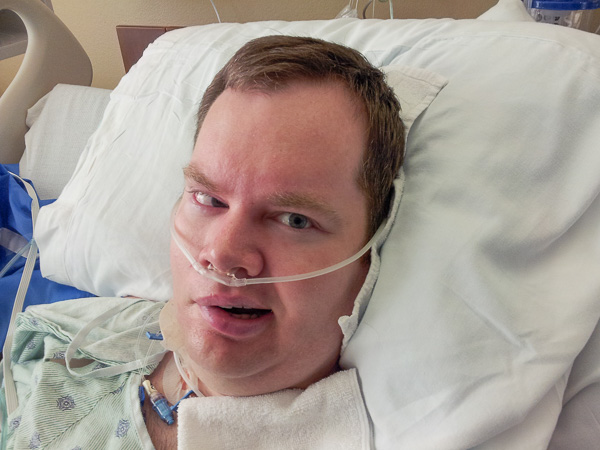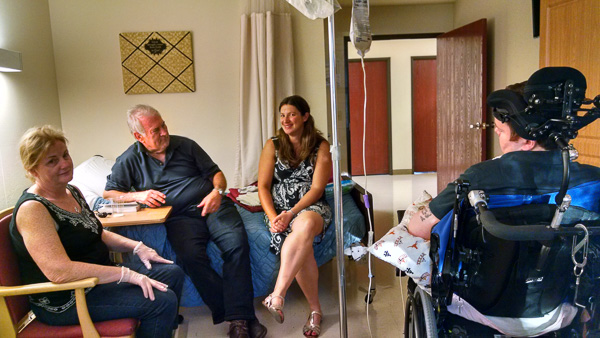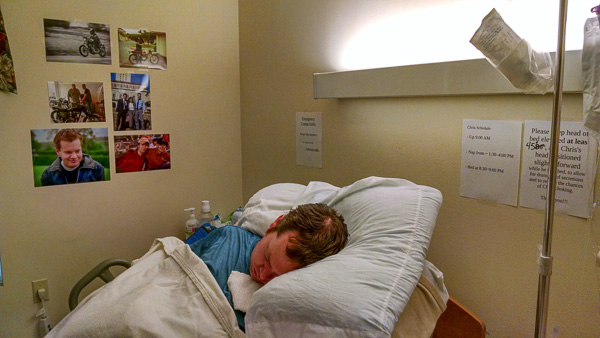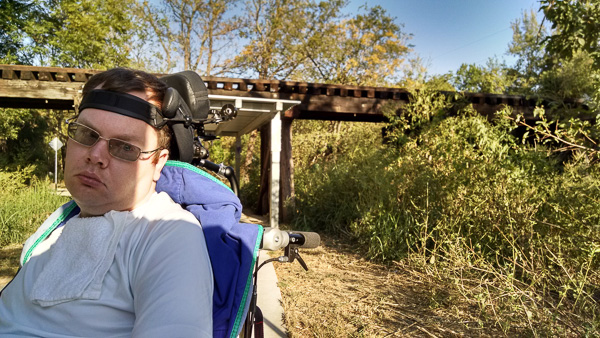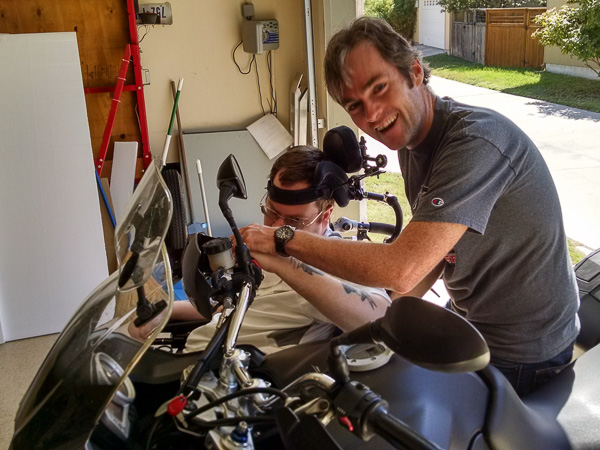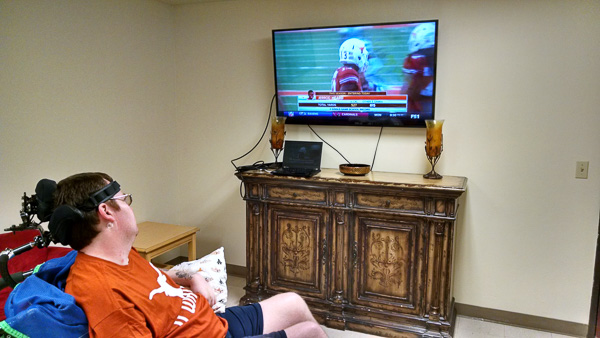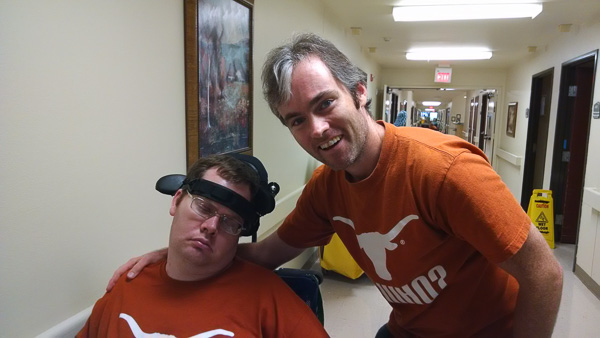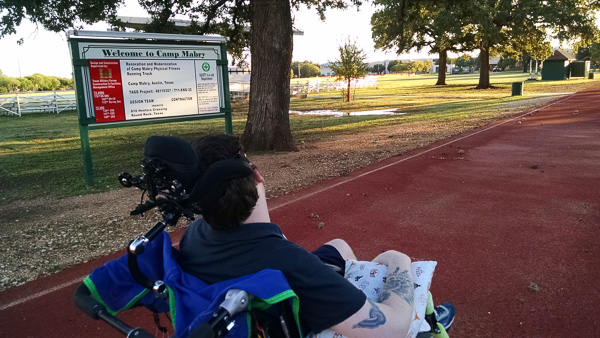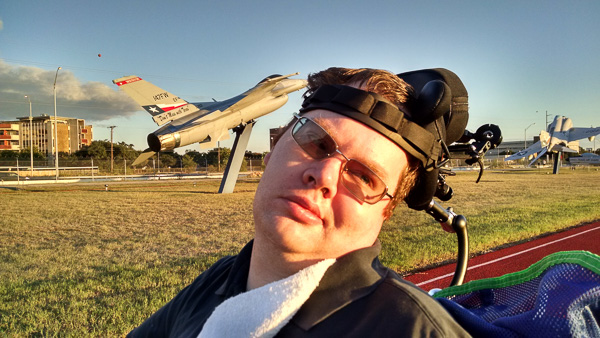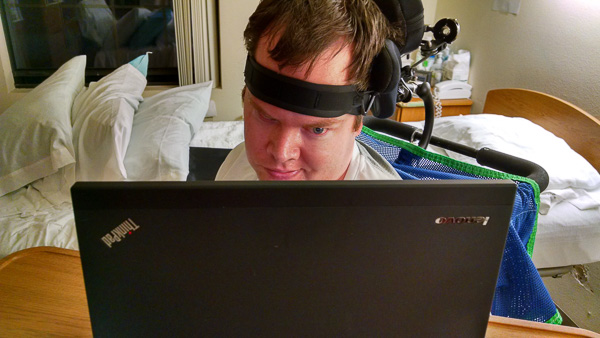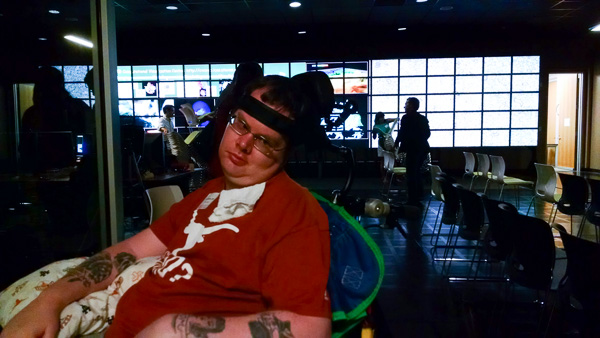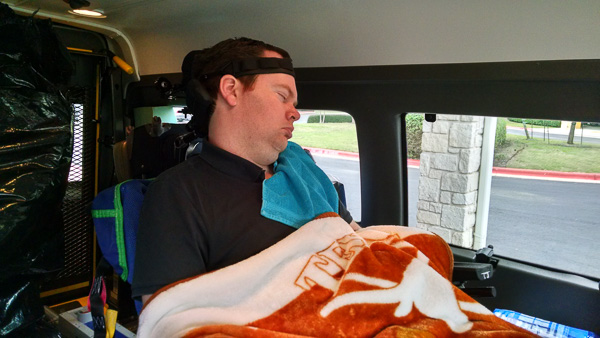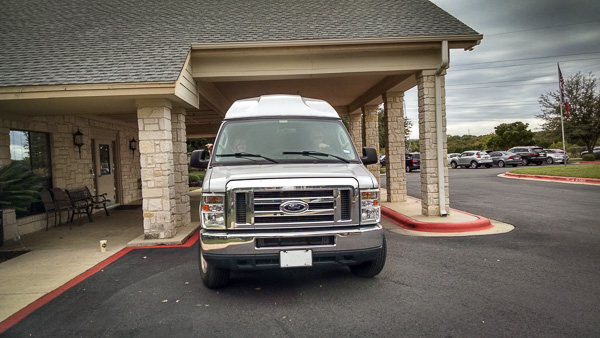I’ve been meaning to post an update for quite a while now; sorry folks.
P300 Speller:
I’m going to rewind to late November / early December 2014, when I filled in for my parents while they took a very-needed vacation.
The week or so they were away and the upcoming Christmas holidays provided a unique opportunity to evaluate a patient-ready brain computer interface P300 spelling system, intendiX, produced by Guger Technologies in Austria:
http://www.biosignal.at/Intendix/intendix_speller.htm
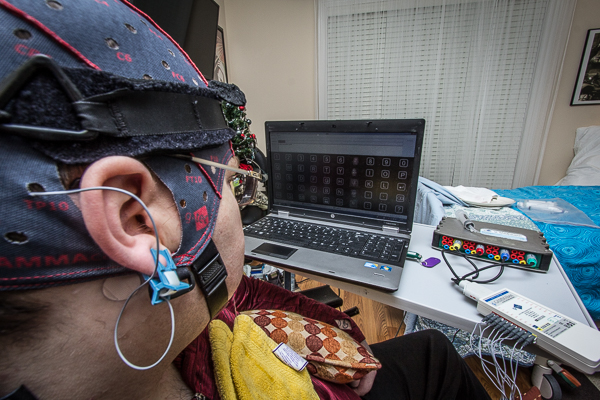
Chris’s wheelchair headrest strap makes attaching the EEG cap a little difficult
The system measures immensely small voltages for eight specific areas on the scalp (single ear lobe as reference / ground), using conductive electrode gel and electrodes that are pre-sewn into a mesh cap. The electrode wires go off to a small battery-powered amplifier, and from there into a proprietary signal processing device that shows up as a custom USB device, connected to a standard Windows 7 64-bit laptop:
The other half of the magic is within the actual software itself. The display consists of a rows and columns of letters and numbers, with a layout similar to a standard QWERTY keyboard. You create a classifier for a particular person by “spelling” a handful of pre-selected words. For example, using “BOB” to create a classifer:
- The system shows the letter “B” in the center of the screen for 1 second, to indicate the next expected letter to “train”.
- Entire rows and columns of letters / numbers begin quickly flashing, randomly, across the screen. The letters / numbers of a particular flashing row or column are very briefly – milliseconds – replaced with small photos of a famous actors / actresses (probably to elicit a heightened response to human faces appearing).
- You simply focus on the letter “B”, and count the number of times the row or column containing the letter flashes. The system kind of converges on the row/column response after about 20 repetitions for each letter.
- The system shifts to the next letter in the training, “O”, and the process repeats:
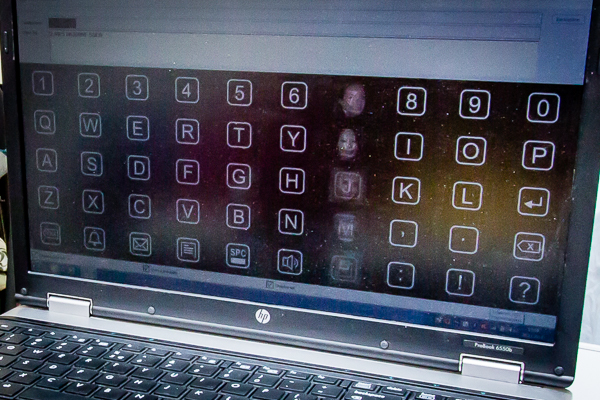
Rows and columns flash across the screen
Once you’ve created a classifier, you can begin using the system to actually spell words by simply looking at the letters / numbers on the screen. You basically just stare at an individual letter as the rows/columns flash, and eventually it will pop up on the screen.
It’s pretty amazing. I tried the system out on myself, to make sure I was doing things correctly when I worked with Chris. It was quite reliable and very repeatable – for a fully conscious, healthy person, it was extremely straightforward. The training was short, too – it worked for me after only one training word.
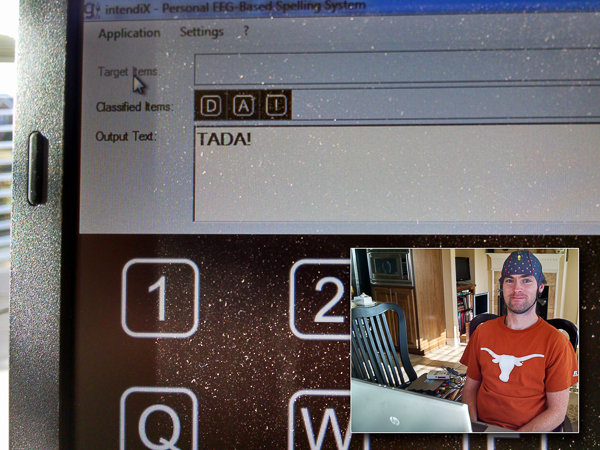
No hands! I spelled “TADA!” just by looking at the characters on the screen.
The lousy part – the hospital detour:
Despite having the intendiX system from the end of November through the Christmas holidays, we didn’t really get a chance to use the system with Chris for very long…
Chris started acting a little bit weird – more absence seizure-type stuff (staring off into space) – the day or two before my parents left for their trip. After my folks were out of town, Chris began having nightly tonic-clonic seizures. It became progressively worse and worse as the week went on. Initially it was one seizure a night, then two, then during the day and night, then multiple tonic-clonic seizures during the day.
After the first seizure, I started keeping a laptop next to the bed at night, to watch and listen to the camera feed from Chris’s room. The seizures always seem to be shorter when someone is in the room holding Chris and talking to him softly, if you can scramble out of bed when it starts happening…
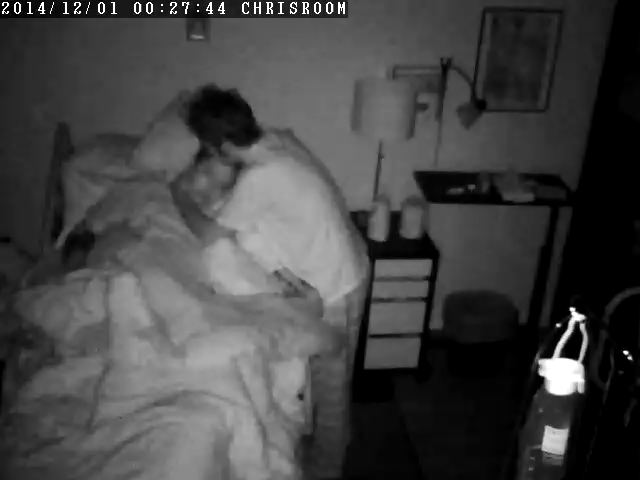
We went to the local emergency room to check for infection, since that sometimes seems to cause seizures for Chris. Tests came back negative, but the tonic-clonic seizures continued to increase in frequency. I made an appointment to see a neurologist after another day or so of this, and he had a seizure in the neurologist’s waiting room! The nurses there had us wheel across the street to the county hospital’s emergency room instead, where things continued to slide downhill, to the point where Chris and I ended up in the hospital’s neurological intensive care unit: status epilepticus (back to back to back to back… seizures).
Hearing a hospital-wide neuro response team code announced, surrounded by nurses who had run out of options and couldn’t conceal the alarm on their faces, was a pretty damn scary time.
The only thing you can do is basically just knock the person out cold – in this case, using an emergency dose of Benzodiazepines. They had Chris hooked up to an EEG for a 24 hour recording, and the seizures continued off and on, just in a non-presenting fashion.
My folks knew about one or two of the night time seizures earlier in the week, but this had progressed to the point where I finally had to let them know that I absolutely did NOT have things under control, guaranteeing the vacation THEY REALLY NEEDED would prematurely – but necessarily – come to an end.
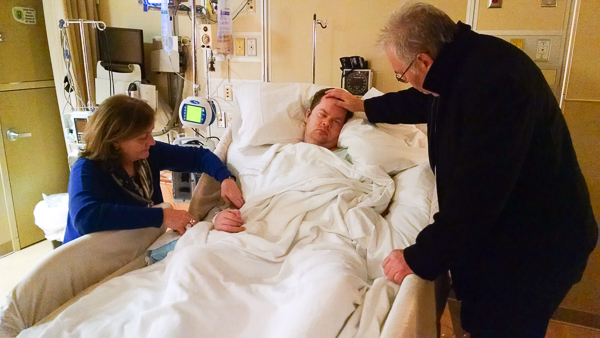
RELIEF!
I was bloody glad to see my parents, and I know Chris was, too.
We spent another two days in the Neuro ICU, with the neurologist running through two different choices of anti-seizure medication, before being released to a step-down unit for a few days, and eventually home.
The neurologist had no ideas about any specific triggers for this bout of seizures; he basically chalked it up to “brain injury”, and that was that. Chris is on a new, secondary anti-seizure medication now and hasn’t had any subsequent tonic-clonic seizures at night (and generally seems more alert during the day, which is one good thing that came out of this hospital ordeal).
We have another theory – might be daft – some of the seizures might have been non-epileptic, induced by Chris’s general panic of not having my mom around. I remember some of the seizures at night seemed to dramatically calm down when I touched Chris, which shouldn’t happen for a “real” seizure…
P300 Speller, continued:
Getting back to the intendiX speller: we’d only been able to use the system twice when Chris had his first night time tonic-clonic seizure under my watch. I decided not to put any further flashing lights – the rows and columns of the intendiX screen – in front of Chris, until the seizures seemed to be reliably behind us. That put things toward the very end of December, a few days before we had to send the system back. D’oh.
I spent a few more hours trying to get Chris to train a few words with the system, but we unfortunately didn’t have any luck. The Austrian company looked at one of the data sets and said Chris is having “P300 responses”, but I just didn’t have any luck at all creating a consistent classifier that we could use to spell any words with.

MATLAB: It’s everywhere!
The intendiX system is promising for the future, though, and especially for other traumatic brain injury patients that are perhaps a little further along than Chris.
The system isn’t quite turn-key enough yet for my parents to casually use – the electrode gel makes a big mess everywhere, and you have to be really careful about not moving the electrode cap around, which is difficult to do given Chris’s wheelchair headrest, and that he cannot hold his head up on his own.
We’ll probably give the system a shot again in the future, when I can spend another week or two with Chris out at my folks’ house.
Smiling
I’ll end this update with some really good news. My parents have been saying this since the beginning, but Chris really does understand what we’re saying to him most of the time. You can tell the guy a joke, or remember something funny from way back when, and he’ll crack a smile almost immediately:
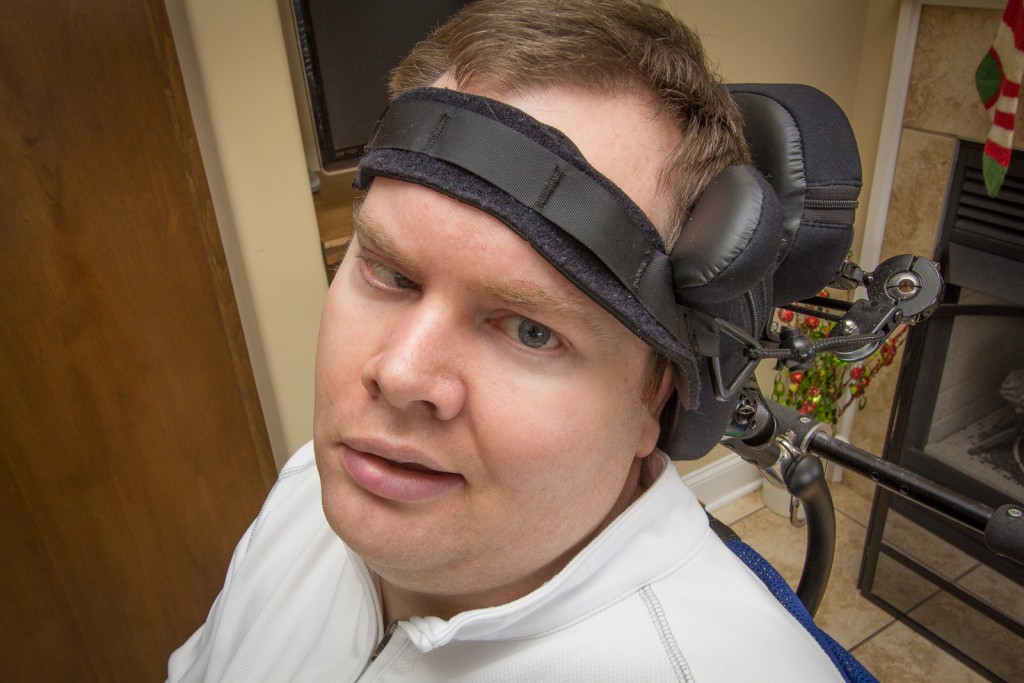
This past November was kind of the first time I’d observed it, in a repeatable – no way, this isn’t just chance! – consistent fashion.
There’s still a long bloody way to go, but knowing Chris has comprehension of language is huge.
So there’s some good news to wrap things up. Also – my folks might make a trip out to Austin soon with Chris, but we’re still working out the details on that.
The Town Lake trail – one of our favorite locations to run and solve the world’s problems – is wheelchair accessible.

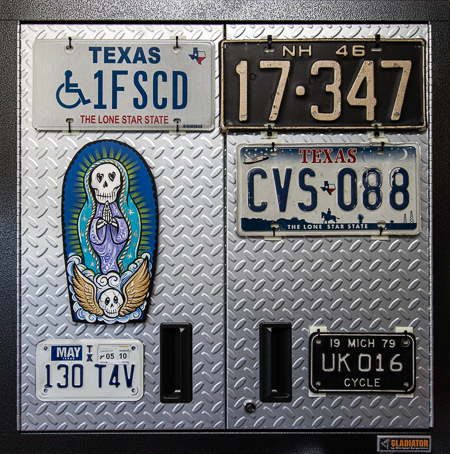



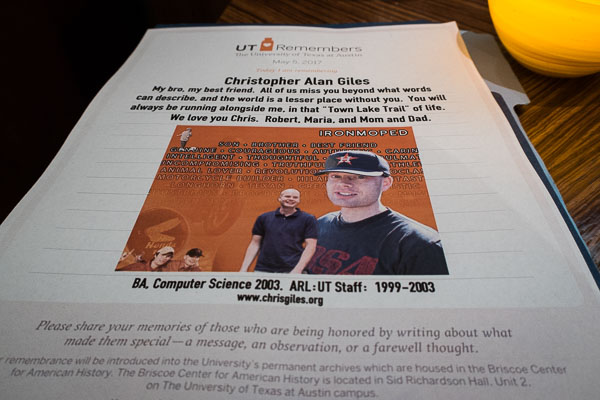
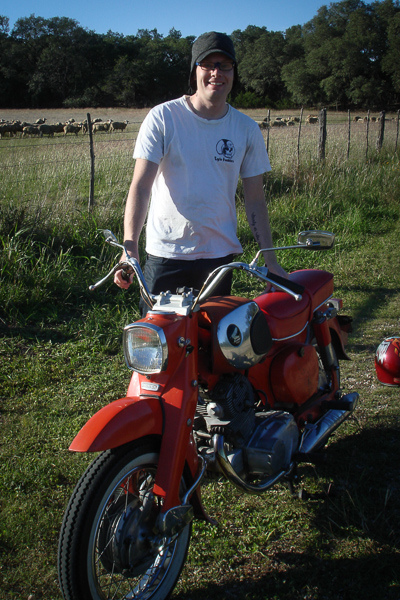 There will be a memorial for Christopher in Austin, Texas, on Sunday, June 5th, 2016, at 2PM.
There will be a memorial for Christopher in Austin, Texas, on Sunday, June 5th, 2016, at 2PM.